Thermometry
Thermodynamic quantities
The measurement of thermodynamic parameters is a decisive factor for quality assurance in almost every industrial sector. In our thermometry, temperature and climate/humidity and radiation temperature laboratories, our technicians work with temperature control equipment from -80 °C to 1210 °C and from 5 % RH at 98 % RH from -10 °C to 95 °C. In the field of thermometry, esz AG also offers the lowest measurement inaccuracies and a comprehensive portfolio for the calibration of temperature and humidity measurements.
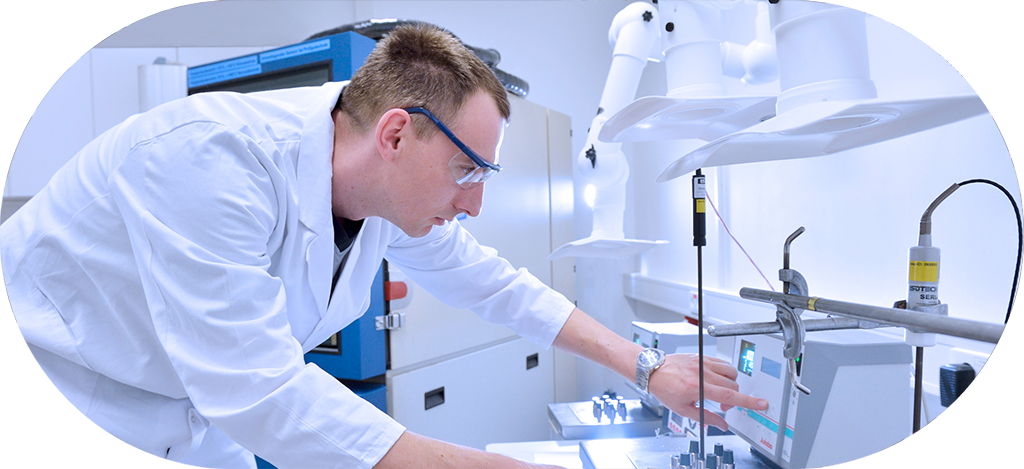


Your calibration offer
We’ll be happy to provide you with a no obligation quote for the calibration of your measuring devices.
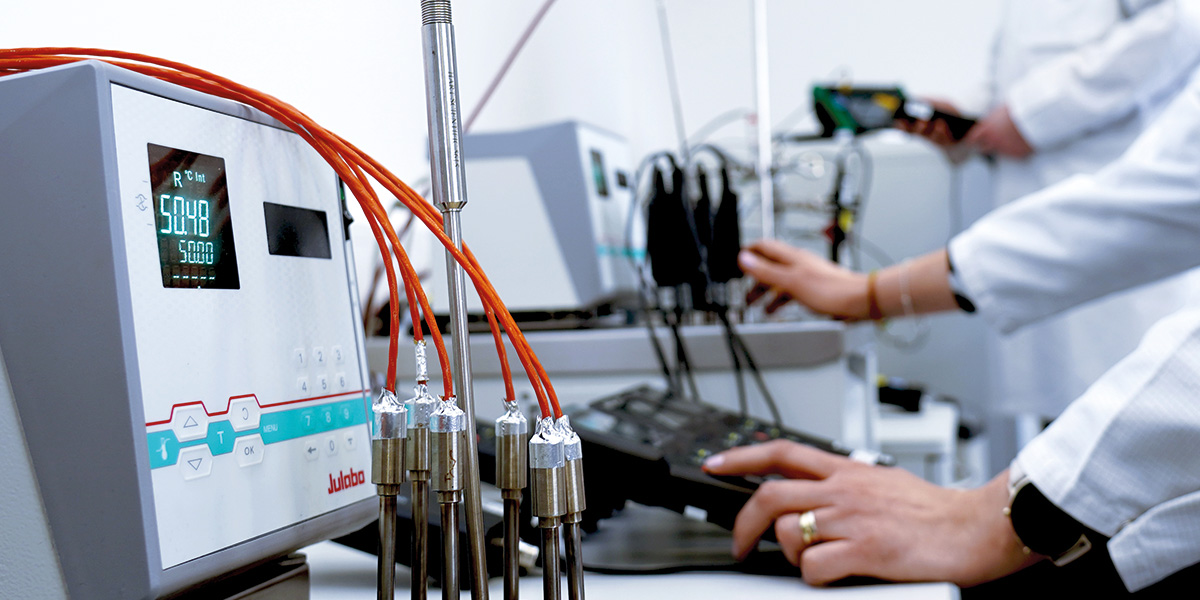
Thermometers
The recording and calibration of temperature is of great importance in thermometry. By directly monitoring the temperature, quality criteria for various products (e.g. food, steel, plastics industry) are met, in which the evaluation has a direct influence on the control of production systems. We mainly use calibration baths (thermostat baths) with different media (ethanol, water and silicone oil) and dry block calibrators with different measuring ranges for calibrating insertion or immersion sensors. Using high-precision platinum resistance thermometers and thermocouples with minimal drift and individual correction values, we achieve the smallest measurement uncertainties from 20 mK. We even achieve 15 mK at the water triple point. The basic electrical variables for thermoelectric voltage and resistance are traced back to the electrical laboratory, which means that measurement uncertainties of less than 2 mK can be derived for temperature display and simulation.
Infrared thermometer and pyrometer calibration
Non-contact infrared thermometers are calibrated on a black plate radiator which, together with a sharp-point pyrometer, enables the transfer of radiation temperature in the spectral range 8 µm to 14 µm and temperatures from -15 to 500 °C.
In thermometry, pyrometry refers to all measurement methods that allow the temperature of surfaces to be determined. To do this, the technicians carry out an energetic or spectral evaluation of the thermal radiation emitted by the surface. Measurements are taken using a pyrometer, also known as a radiation or infrared thermometer.
Thermography, on the other hand, could be defined as imaging pyrometry. Pyrometers enable a ‘point-by-point’ statement about the surface temperature of a measured object. The signal conversion (heat radiation from the object = measured value) is similar in the pyrometer and in the thermographic system and is subject to the same physical laws. Our eyes receive information that consists mainly of reflected light.
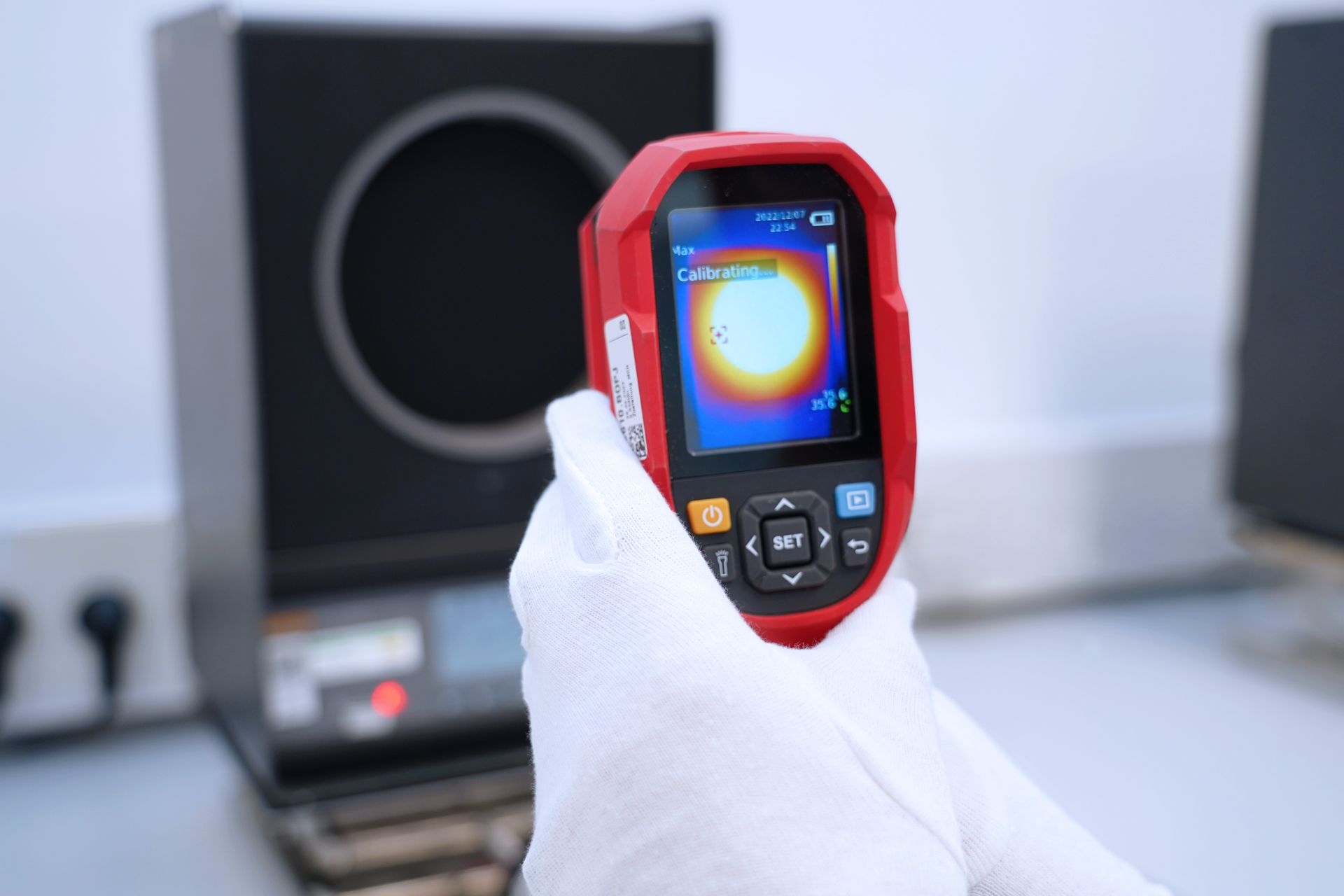
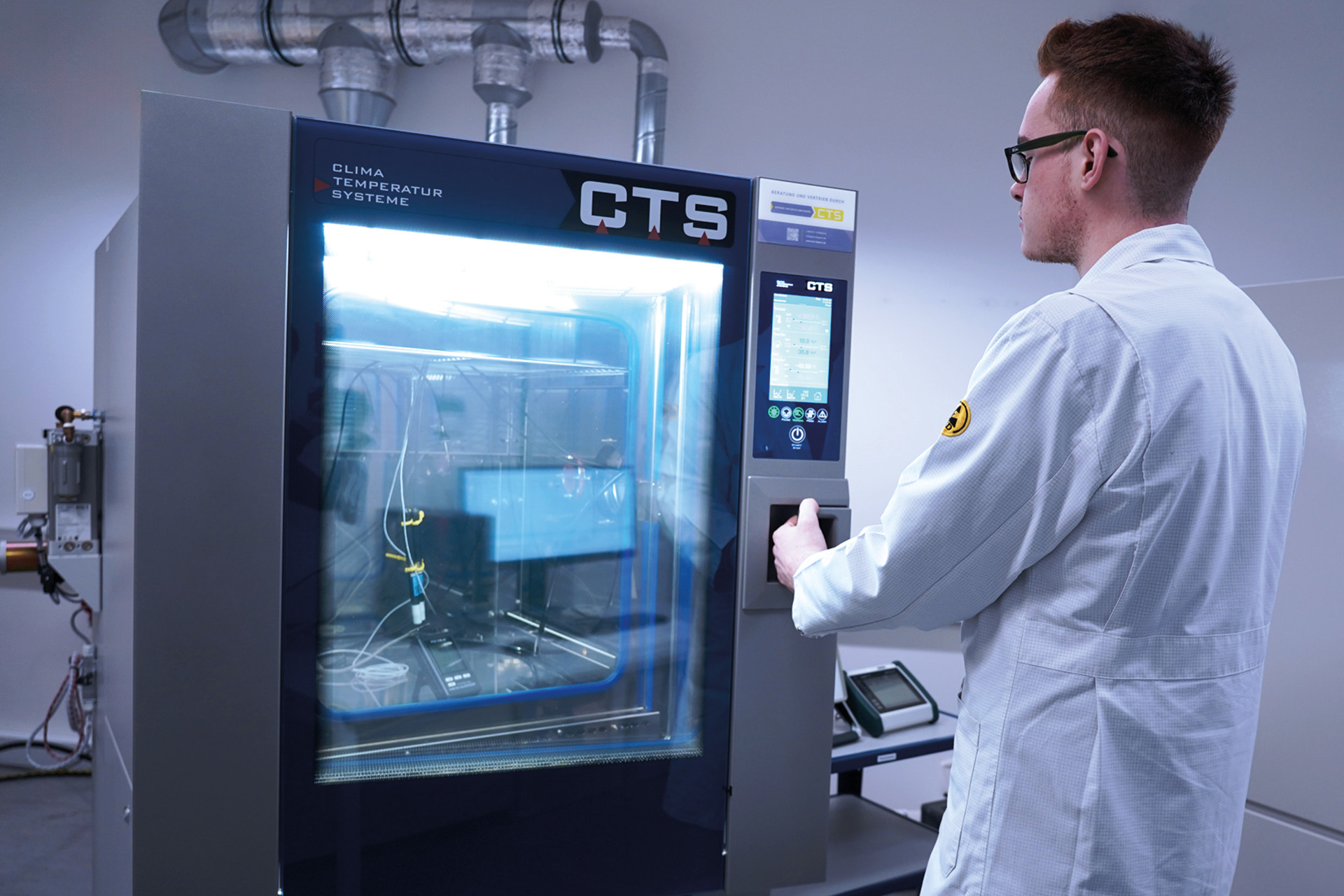
Block calibrators, temperature control units and climate chambers
Block calibrators are characterised in accordance with DKD-R 5-4 (Calibration of block calibrators). With the help of high-precision Platinum resistance thermometers or precious metal thermocouples, the influencing variables such as instability, radial and axial homogeneity as well as the Determined display deviation.. Calibration for thermostatic baths is carried out in a similar way.
We use measuring systems and procedures in accordance with DKD-R 5-7 to calibrate climate chambers or climatic chambers. This means that we can also offer customers from development or production a professional calibration of their devices. In our thermometry laboratories, we record the characteristic features of climate chambers at nine measuring points in the chamber volume and evaluate the statements about instability, inhomogeneity and the influence of radiation. The calibration also provides results on display/setting deviations and the uncertainty of climate parameters under defined conditions.
Relative humidity
Calibrating moisture meters requires the highest level of metrological expertise. Our accredited humidity laboratory is one of the laboratories with the smallest measurement uncertainties in Europe.
We offer these calibrations in various humidity generators, e.g. the Rotronic HygroGen2-XL or in the climate chamber. Numerous climate chambers and temperature control units are available for this purpose in our laboratory area for climate/humidity. In addition to capacitive and resistive humidity measuring devices/data loggers/transmitters, esz AG also calibrates high-precision reference standards such as dew point mirrors and dew point transmitters. The calibration of climate recorders, loggers and measuring devices is carried out in climate generators in a stabilised humid air flow. The reference standard is a high-precision dew point mirror which guarantees the traceability of the measured variable “relative humidity” via the thermodynamic relationships between absolute humidity (dew point temperature) and air flow temperature. At the same time, continuous validation against capacitive precision humidity sensors with short response times is carried out.
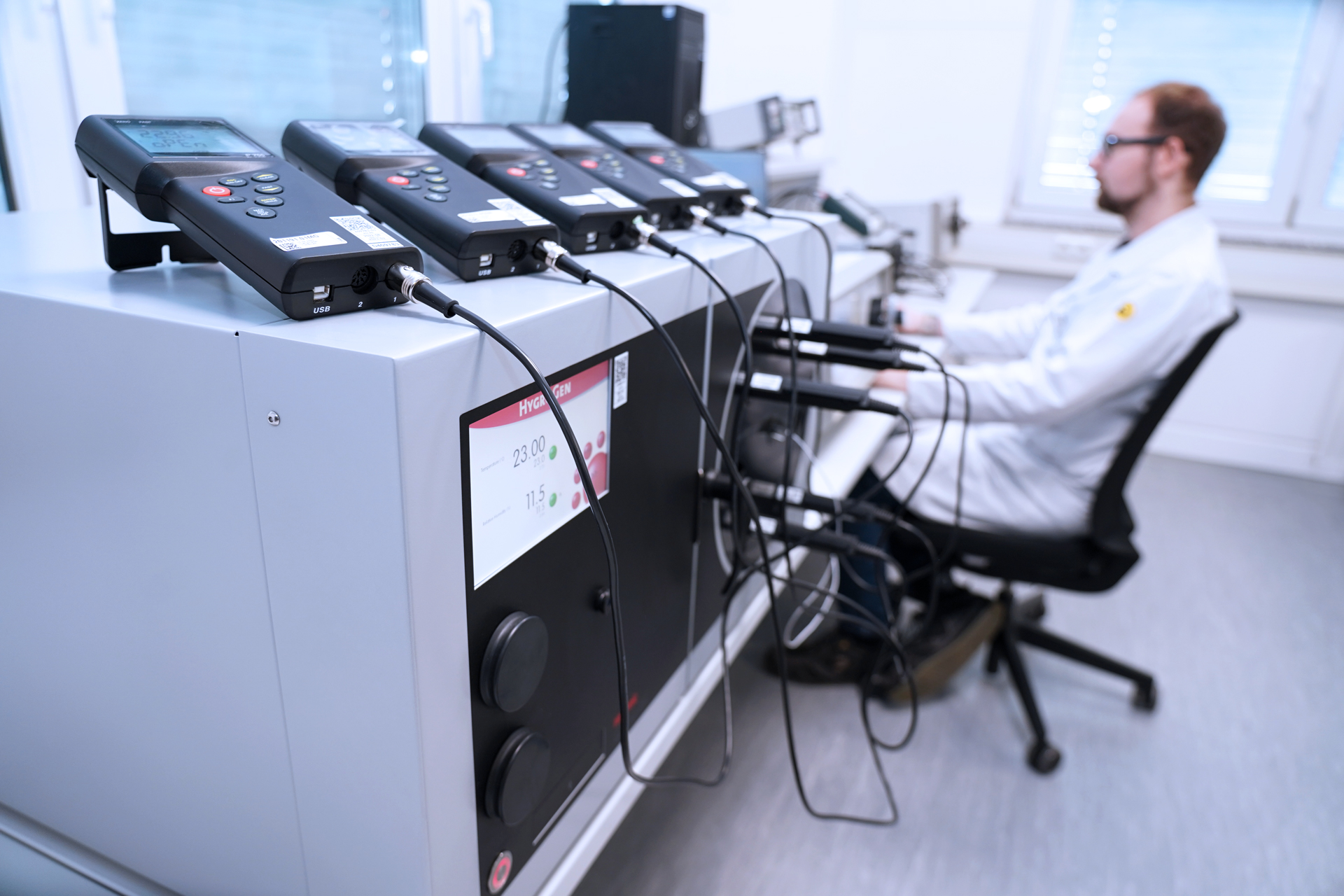

Service
Logistics Expert
With the esz AG collection and delivery service, your sensitive test equipment is always in safe hands. Choose between individual collection and delivery or our weekly delivery service with fixed routes.
Your benefits
- Full service – everything from a single source
- DAkkS-accredited calibration of many thermodynamic testing devices
- Wide measuring ranges with minimal measurement uncertainties
- Climate chambers and humidity generators for parallel measurements
- Calibration of reference standards in our laboratory
More information
DAkkS & Factory/ISO calibration
- Temperature quantities
- Resistance thermometer
- Thermocouples, thermoelements
- direct-reading thermometers
- Temperature indicators and simulators
- Climate cabinets (temperature)
- Surface thermometer, also direct reading
- Liquid glass thermometer
- Radiation thermometer
- Block Calibrators
- Infrared radiators
- Calibration baths
- Moisture quantities
- Humidity and dew point temperature
- Climate cabinets (humidity)
- Measuring instruments for relative humidity
- Measuring instruments for absolute humidity
- Thermometers
- Temperature measuring devices
- Temperature sensors
- Temperature calibrators
- Block Calibrators
- Thermocouples
- Climate cabinets
- Temperature cabinets
- Climate and humidity measuring devices
- Dew point measuring devices
- pH value measuring devices
- Conductivity meters
- IR and radiation thermometers
- Surface temperature sensors
- Thermal imaging cameras
Today, the possibility of calibrating and measuring temperatures with thermometers is based on the thermoelectric relationships between voltage and resistance and is measured using thermocouples or resistance thermometers. The starting point is the definition of the temperature scale according to ITS-90, which only uses fixed or triple points as supporting points. The central pivotal point here is the triple point of water, whose properties in the liquid, solid and gaseous state are used to define the temperature at exactly 0.01 °C. In contrast to the ice point, which is dependent on air pressure and the amount of dissolved oxygen, the triple point is always exactly repeatable. In the esz AG temperature laboratory, this important reference point is realized in a slim fixed-point cell and can be maintained for up to one day.
The “self-illumination” of the objects, the heat radiation emitted by the different surfaces, is invisible to our eyes in the room temperature range. For reliable calibrations and measurements, it is always necessary to know the emissivity of the heat-emitting surface. This is because real radiators only emit part of the radiation of the black body. The deviation of the real temperature radiator from the black body is defined by the emission coefficient. It depends on the material, the surface quality, the temperature and the wavelength. In the esz AG temperature laboratory, emitters with emissivity e = 0.95 are used or referred to.
The dew point hygrometer is a measuring device (hygrometer) for determining the dew point of water in air. The dew point is the temperature at which a state of equilibrium of condensing and evaporating water is reached on an object in the presence of moisture, in other words condensation is just beginning to form. The dew point mirror hygrometer works according to the fundamental direct measuring principle and uses a temperature-controlled mirror to measure the dew point. The measurement measures the reflectivity of the mirror, which begins to decrease as the temperature falls when the dew point is reached and the mirror fogs up.

